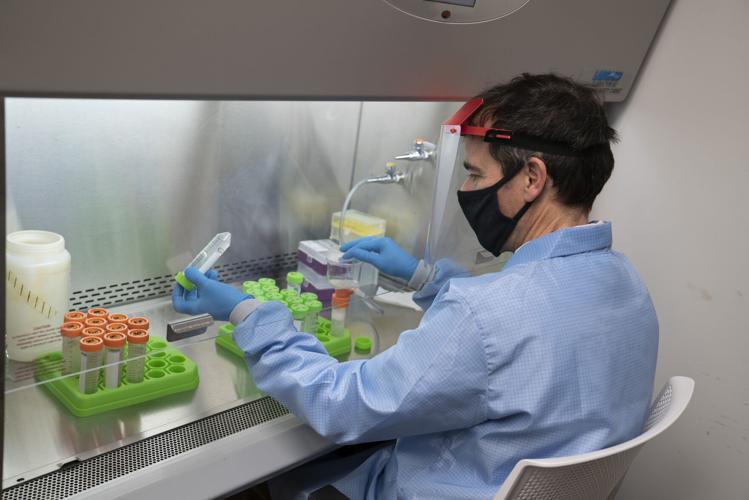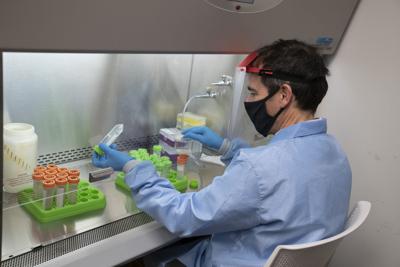While most students are aware of Penn State’s walk-up and randomized coronavirus testing, there’s other testing strategies happening beneath the surface of campus.
Wastewater testing for the coronavirus has been part of Penn State’s layered testing strategy since before the 2020-21 school year. Starting in July 2020, a team of university professors and experts began sampling wastewater from both on-campus and off-campus areas in State College, according to Heather Preisendanz, associate professor of agricultural and biological engineering.
The team of researchers got its start for the project through the Penn State College of Agricultural Sciences and Penn State’s Wastewater Treatment Plant that was already on campus.
When the coronavirus pandemic erupted around this time last year, faculty in the College of Agricultural Sciences were looking for ways to work on issues related to the pandemic, Preisendanz said.

Preisendanz, who was already working with the Wastewater Treatment Plant, found wastewater testing was a valid form of testing that Penn State could manage with the relationships it had already created with the plant and the University Area Joint Authority, which provides wastewater treatment to the local area.
“It just seemed like a natural extension to the things that we were already doing and the partnerships we already had,” Preisendanz said.
The project started off by testing wastewater samples that left the Wastewater Treatment Plant. This “effluent” gets spray-irrigated in fields near the State College airport where people tend to recreate as well, according to Preisendanz.
It was important to the team and Penn State, Preisendanz said, that the technologies the treatment plant was using effectively removed the virus before the effluent left the plant.
“We could reassure the public that [the virus] is not being irrigated onto these fields that people are utilizing. There are just lots of benefits for this partnership to figure out what’s going through the treatment plant and what’s leaving the treatment plant,” Preisendanz said.
Wastewater samples are gathered from manholes that receive wastewater flow from on-campus and downtown borough areas, as well as the Wastewater Treatment Plant. Samples are collected compositely over the span of 24 hours.

Michael Shreve, a post-doctorate in the Department of Agricultural and Biological Engineering, leads the field sampling for the wastewater testing project.
“All the samples over a 24-hour period go into the same jug, and that’s then representative of what flowed past during that period,” Shreve said.
This method, along with the frequency of testing, has allowed the team to discern when there’s any sign of the virus in State College.
“We were able to see the absence of the virus before the students returned and the presence of the virus after they returned,” Shreve said.
This became important when analyzing the data and determining whether there was an increase or decrease of coronavirus cases on campus. According to Cara Exten, infectious disease epidemiologist and assistant professor in the College of Nursing, it was difficult for researchers to detect the flow of cases without this added testing strategy.
“Sometimes you see results and you’re not sure what to make of them or how generalizable it is to the population, but the wastewater gives us additional context to see how to interpret the results we’re seeing out of the test sites,” Exten said.

According to Exten, the increased testing strategies made it easier to correctly identify where case increases were happening on campus.
“When you combine the wastewater analysis, surveillance testing and walkup testing data, then you can really pull all that together,” Exten said.
Wastewater testing has proved to do more than just provide context to other testing strategies, though.
“One of the things that’s unique about wastewater testing for COVID-19 is it can be used as a leading indicator,” Shreve said. “People start to shed the virus before they become ill and seek out testing or treatment, so we’re able to detect increases or changes about seven days before it turns up in case data.”
The layered testing strategy gives researchers at Penn State better ideas as to how to direct future testing as well.
“[Wastewater testing] doesn’t tell you who’s infected, so now we know when we need to increase random testing,” Preisendanz said. “The allocation of individual resources can be thought about.”

Shreve said wastewater testing can help save costs, because it’s cheaper than human testing — such as walk-up or random testing. He added that this could be helpful for the university as the pandemic begins to decline.
As the rate of the pandemic slows down and the country begins to see the light at the end of the tunnel with vaccine distribution, the hope is to continue wastewater testing to monitor coronavirus levels at Penn State, according to Shreve.
“Not only will we be able to see any resurgence at the campus level or community scale, we would also be able to verify the absence of the virus,” Shreve said. “Rather than testing everybody to see if everyone’s negative — which is fairly expensive — we can test the wastewater and see if it’s negative.”
According to Exten, the potential for wastewater testing is “good.” As disease surveillance is a challenge for health professionals and researchers in the public health field, wastewater testing can provide important insight into infectious disease prevalence throughout a community.
“We’re always trying to get an idea of what’s going on in the community, we’re always trying to understand how much disease is in an area,” Exten said. “I think that wastewater has a really strong potential to keep us informed about the health of our communities.”









